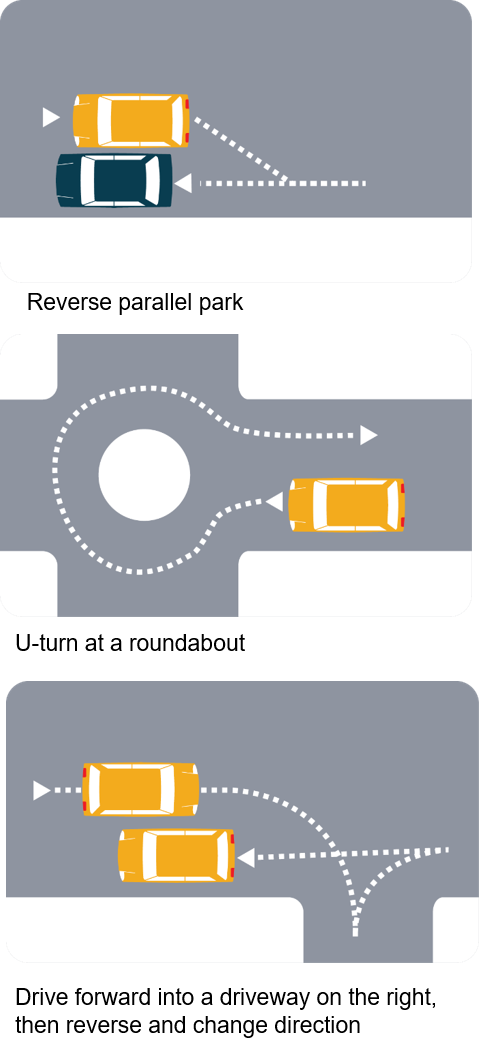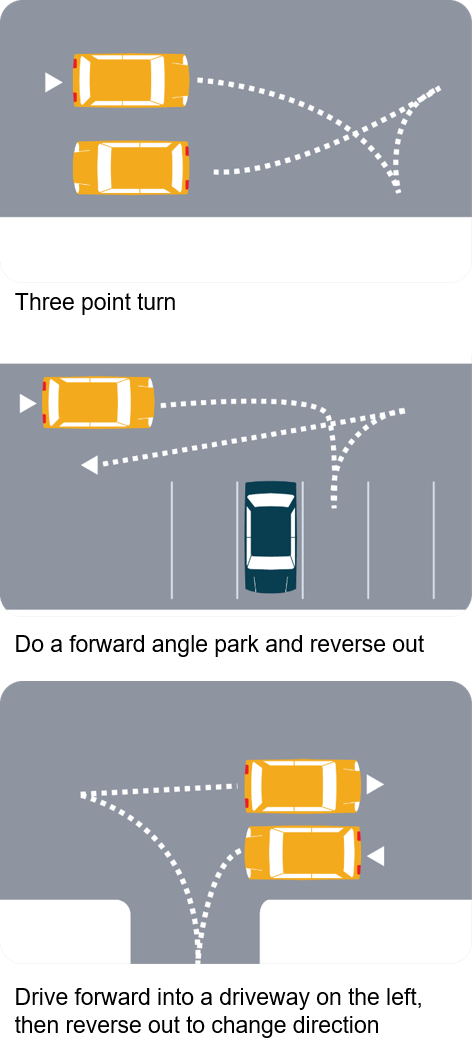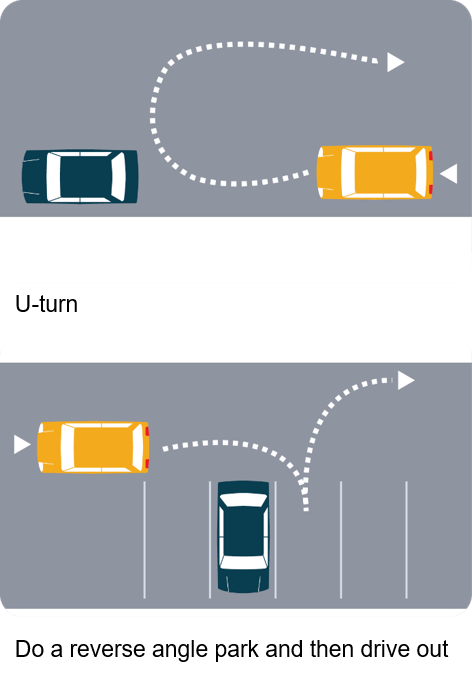Learning stages and manoeuvres
When you first start driving, you will learn car control and the basic driving skills that are needed to drive safely.
Stage 1 goals
Your goals for this stage are to become familiar with the various car controls and begin to build your confidence using them.
Aim to:
- be able to adjust your seating, mirrors, steering wheel and any other controls required to ensure a safe position
- start and stop the car’s engine
- check your mirrors when required
- stop the car on a slope and move off using the handbrake (or parking brake)
- reverse in a straight line and around a curve
- corner smoothly at a low speed
- brake smoothly to bring the car to a stop
- check your blind spot if moving onto the road from a kerb
- smoothly change gears if driving a manual.
How to develop these skills
To learn how to use your car’s controls, you’ll need to be shown how and when to use them. Then you need to practise in quiet areas. As you get more experience, you will need to practise in more locations and different conditions.
The first step is getting familiar with being in a car. Before setting off on your first drive, you should sit in the driver’s seat with the engine off.
- Get used to the feel of sitting in the driver’s seat.
- Adjust the car mirrors so you have a clear view of the rear and sides of the car.
- Find and apply the handbrake, foot brake, accelerator and gear stick.
- Use all the switches and controls (indicators, lights, windscreen wipers) so you’re familiar with where they are and what they do.
- If you’re learning in a manual, apply the clutch and change the car through the gears (including reverse).
When you feel comfortable sitting in the driver’s seat, learn how to:
- start and stop the engine
- steer the car
- move the car forwards and backwards
- drive the car and stop at a certain point.
Selecting places to drive
When you first begin, a quiet wide street or carpark is a good place to start. Your supervisory driver needs to help you scan on and around the road for hazards (like pedestrians, cars or motorcyclists pulling out).
Your car control skills have improved by now and your reactions are becoming more automatic. You can put your skills into practice to move smoothly into traffic while being alert to hazards.
In this ‘basic drives’ stage, you will be getting a lot more driving experience. Slowly begin to expand this experience to different situations and road, weather and traffic conditions. Also start to increase the length of your practice sessions.
The basic drives stage consists of:
- starting to increase the length of your driving sessions
- driving in different areas with more traffic
- beginning to practise driving in different weather and traffic conditions (light or heavy traffic, wet weather)
- practising manoeuvres like three-point turns, U-turns, parking and reversing.
Stage 2 goals
Your goals for this stage are to:
- drive smoothly when doing manoeuvres, and when driving around bends, on hills, at intersections, when merging and when changing lanes
- obey all road rules when driving
- start making driving decisions (this shows that you’ve started to think in advance)
- think about where you want to drive next
- use clues like information signs, landmarks, and road signs/ markings to help you work out where you need to drive
- be able to change your driving route to get back on course if you find you’ve turned into the wrong street
- watch out for other road users (including pedestrians, cyclists and other drivers) when driving
- be able to pick gaps in traffic when turning or changing lanes
- adjust your speed to match the road, weather and traffic conditions.
You will find further help on planning driving sessions on the Supervisory driver tips page.
Starting out in Stage 2
Time (approximately): Up to one hour
Location (find a location that suits your learner’s ability and vary the locations so they don’t become boring):
- busy suburban street or country town to do car control tasks
- quiet, wide street in the suburbs or country town to practise manoeuvres.
Driving tasks:
- car control tasks from Stage 1
- some manoeuvres (see below).
Feedback:
Continue to give your learner positive feedback on their driving. Suggest ways to improve those areas of their driving that still need work.
During Stage 2
Time (approximately): One hour for formal sessions
Location (find a location that suits your learner’s ability and vary the locations so they don’t become boring):
- choose road and traffic situations that suit the tasks you’re doing
- change the locations so your learner gets experience in different traffic and road conditions.
Driving tasks:
- change lanes
- turn at a slip lane
- merge lanes
- hill starts
- all the manoeuvres.
Feedback:
Let your learner know if they forget to make a decision or if they have made the wrong decision. This may be forgetting to indicate or deciding to go into a bend at the wrong speed.
At the end of Stage 2
Time (approximately): One hour for formal sessions
Location (find a location that suits your learner’s ability and vary the locations so they don’t become boring):
- choose road and traffic situations that suit the tasks you’re doing
- change the locations so your learner gets experience in different traffic and road conditions.
Driving tasks:
- all the manoeuvres
- practise giving way to a pretend emergency vehicle in a quiet location
- forward parallel park.
Feedback:
Start encouraging your learner to pick up on their errors – ‘What did you forget to do?’ or ‘Do you know what went wrong?’
Now your car control skills are automatic, you will be able to link different controls together to perform different driving manoeuvres.
It is a good idea to go back to a quiet wide street or carpark when first learning and practising manoeuvres. Move to a busier location when you feel comfortable. You may want to watch your supervisory driver demonstrate and talk you through some of the trickier manoeuvres before you try them.
Manoeuvres are a key component of the P1 PDA and you will need to be confident in executing them before you can drive solo.



You will now have good car control skills. You have experience using these skills to perform manoeuvres and drive for longer. You have begun to experience different conditions.
The ‘complex drives’ stage consists of:
- developing higher-order driving skills: hazard perception, decision-making and risk assessment
- further expanding your driving to different conditions and unfamiliar locations
- increasing your night-time driving.
Stage 3 goals
Your goals for this stage are to:
- drive safely in busy traffic
- be comfortable driving at higher speed limits (within your learner maximum of 90 km/h)
- be comfortable driving in different weather and road conditions
- decide on when it is safe to enter traffic, change or merge lanes
- drive at a safe speed for the conditions and distance of other vehicles on the road.
Vary your driving conditions
To develop higher-order driving skills, you need to practise in a wide variety of conditions. These include:
- types of road (for example, highways, gravel roads, rural roads)
- weather conditions (rain, fog)
- times of the day (dawn, dusk, night)
- traffic conditions (light or heavy).
To begin with, try one new condition at a time, so you have time to become familiar with each new situation. Once you have had this experience, you can try adding different conditions. For example, try driving on gravel roads during the day, then try again at night. Use your logbook to record your driving experience in different conditions.
You will find further help on planning driving sessions on the Supervisory driver tips page.
Starting out in Stage 3
Time (approximately): One hour for formal sessions
Location (find a location that suits your learner’s ability and vary the locations so they don’t become boring):
- choose road and traffic situations that suit the tasks you’re doing
- to challenge your learner more, try different locations with more traffic.
Driving tasks:
- tasks from Stages 1 and 2
- drive in some of the different conditions, such as on urban and rural roads and on unsealed roads.
Feedback:
Even though your learner has been practising for a long time, each time you drive you still need to make time for an after drive review.
During Stage 3
Time (approximately): One hour for formal sessions
Location (find a location that suits your learner’s ability and vary the locations so they don’t become boring):
- choose road and traffic situations that suit the tasks you’re doing
- to challenge your learner more, try different locations with more traffic
- visit locations at different times of day and in different weather conditions.
Driving tasks:
- tasks from Stages 1 and 2
- drive in more of the different conditions, including in wet weather and at night.
Feedback:
Your learner should now be able to evaluate their own driving performance, so encourage them to pick up on their own mistakes. If they don’t pick up on a mistake, prompt them by asking ‘Do you know what you forgot to do?’ or ‘What went wrong there?’
At the end of Stage 3
Time (approximately): One hour for formal sessions
Location (find a location that suits your learner’s ability and vary the locations so they don’t become boring):
- choose road and traffic situations that suit the tasks you’re doing
- to challenge your learner more, try different locations with more traffic
- visit locations at different times of day and in different weather conditions.
Driving tasks:
- reverse parallel park in a busy residential area
- practise giving way to a pretend emergency vehicle in an area with traffic
- drive in a combination of conditions, such as on an unsealed road in wet weather.
Feedback:
During the feedback sessions, try to get your learner to do most of the talking – talking about their driving makes them more aware of their performance on the road.
In the driving sessions leading up to your P1 PDA, you can focus on the following tasks to make sure you are prepared.
‘Visit a friend’
Instructions: This involves you finding a safe spot to turn around, and then completing a reverse parallel park behind a vehicle parked up the street.
First driving task: Turning around if necessary.
The learner may choose to:
- turn around using a driveway
- do a 3-point turn
- do a U-turn.
Second driving task: Parking outside the house.
The learner will do a reverse parallel park.
‘I left something behind’
Instructions: The supervisory driver will tell the learner they have just visited a friend’s house and remember they have left something behind at the house and need to go back to get it.
First driving task: Turning around to go back.
The learner may choose to:
- turn around using a driveway
- do a 3-point turn
- do a U-turn.
Second driving task: Turning around to park outside the house again.
The learner may choose to:
- turn around using a driveway
- do a 3-point turn before parking at the start location
- do a U-turn.